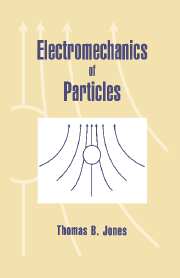Book contents
- Frontmatter
- Contents
- Preface
- Nomenclature
- 1 Introduction
- 2 Fundamentals
- 3 Dielectrophoresis and magnetophoresis
- 4 Particle rotation
- 5 Orientation of nonspherical particles
- 6 Theory of particle chains
- 7 Force interactions between particles
- Appendix A Analogies between electrostatic, conduction, and magnetostatic problems
- Appendix B Review of linear multipoles
- Appendix C Models for layered spherical particles
- Appendix D Transient response of ohmic dielectric sphere to a suddenly applied DC electric field
- Appendix E Relationship of DEP and ROT spectra
- Appendix F General multipolar theory
- Appendix G Induced effective moment of dielectric ellipsoid
- References
- Index
7 - Force interactions between particles
Published online by Cambridge University Press: 02 December 2009
- Frontmatter
- Contents
- Preface
- Nomenclature
- 1 Introduction
- 2 Fundamentals
- 3 Dielectrophoresis and magnetophoresis
- 4 Particle rotation
- 5 Orientation of nonspherical particles
- 6 Theory of particle chains
- 7 Force interactions between particles
- Appendix A Analogies between electrostatic, conduction, and magnetostatic problems
- Appendix B Review of linear multipoles
- Appendix C Models for layered spherical particles
- Appendix D Transient response of ohmic dielectric sphere to a suddenly applied DC electric field
- Appendix E Relationship of DEP and ROT spectra
- Appendix F General multipolar theory
- Appendix G Induced effective moment of dielectric ellipsoid
- References
- Index
Summary
Introduction
In Chapter 6, we presented simple models for the field-induced interactions of linear chains consisting of dielectric, conductive, or magnetic spheres subjected to uniform electric or magnetic fields. In this chapter, we build upon this foundation, using, where appropriate, electrical images or effective linear multipoles to estimate interparticle force magnitudes between particles in electric and magnetic fields. Then, to validate the methodology and to establish its practical limits, we compare results to other theories and to available experimental measurements. Presentation of the force calculation models opens the door for consideration of chaining phenomena in a very broad context, including fieldinduced flocculation, the fibration of particles suspended in liquids, the strongly anisotropic electromechanics of granular media and powders, and the important topic of particle/surface adhesion.
Theory
The effective dipole method espoused in Section 2.4 of this book has as its basis the hypothesis that the forces and torques of electrical origin on a particle may be determined by replacing the actual particle by an equivalent point dipole that creates the same dipolar field as that attributed to the particle. Once the effective dipole has been identified, we may use it in Equations (2.36a, b) to determine the force and torque, respectively. Of course, these equations are only approximations, good only to the extent that the higher-order multipoles are negligible. Their neglect leads to inaccuracies of two types: more obviously, omission of the force interactions among the higher-order moments themselves, but also neglect of the strong influence of the higher-order terms on the dipole itself.
Information
- Type
- Chapter
- Information
- Electromechanics of Particles , pp. 181 - 217Publisher: Cambridge University PressPrint publication year: 1995
